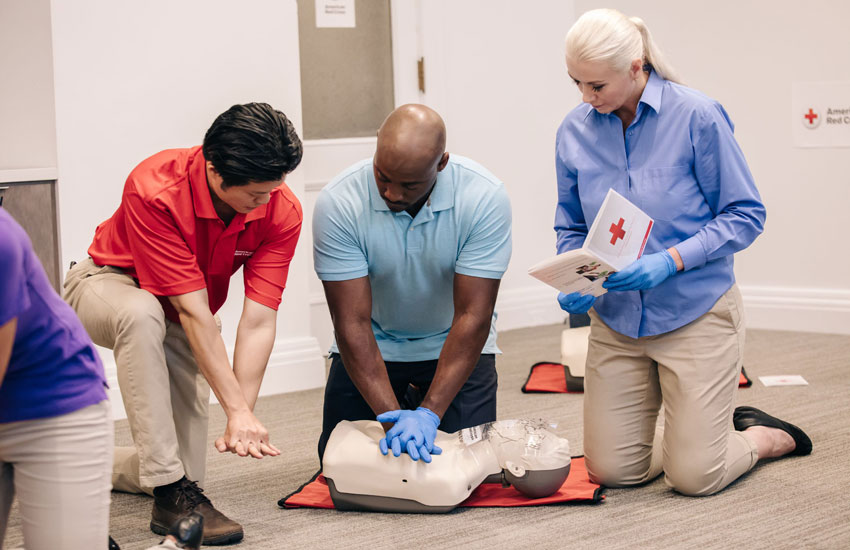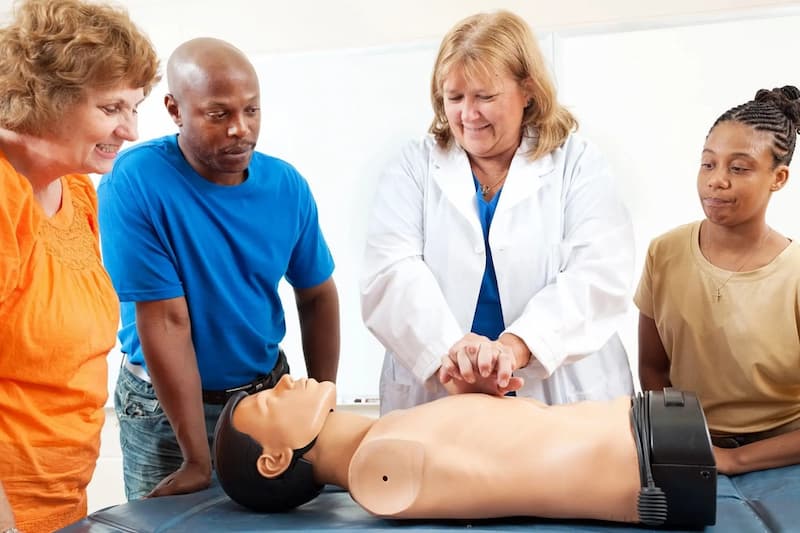
Does BLS Include First Aid? What About CPR
Does BLS Include First Aid? No, the BLS Certification Course does not generally cover First Aid training specifically.
Although some of the training, such as the initial scene size up and patient assessment, does overlap with First Aid, the BLS Certification Course typically does not cover First Aid instruction specifically.
Given that BLS + First Aid are frequently needed for jobs, the majority of training organizations offer courses that include BLS + First Aid for an additional cost.
Please continue reading as I will present you with more specific information.
Table of Contents
Does BLS Include First Aid?
A lot of different things fall under the umbrella of “first aid.” The primary (first) aid provided to people with minor and life-threatening conditions is essentially what the term refers to. BLS and first aid should not be considered interchangeable, even though CPR and BLS skills both fall under the general heading of first aid. Giving stitches, treating minor injuries (or even broken bones), and many other topics will not be covered in BLS certification classes. Verify whether first aid certification will be necessary in addition to standard BLS certification for your line of work.
First Aid Is Useful
Professionals who work with children or in outdoor settings, such as babysitters, nannies, foster parents, expectant parents, teachers, coaches, and others, can benefit from learning about first aid. The training can come in handy when situations do arise and make their employers and clients feel more at ease. Check out this account of a woman who used her training to save her nephew! If you have received CPR training, it could mean the difference between life and death! See more about Why Is First Aid Important?
The Most Important Factor While Providing First Aid
A few years ago, I took a scenario-based trauma first aid course. We had to “save” a life-size articulating mannikin called “rescue randy” that the trainer had hidden. For instance, he could be lying on his back with a broken leg at the bottom of a steep staircase. What do you do?
A scene took place in a dimly lit basement. Upon arrival, randy is found on the ground motionless and seemingly unconscious. We immediately approach and begin performing various checks on his airway.
The trainer ends the situation by stating, “Right, everyone who touched Randy is now dead or unconscious.” Carry on.’
Were all staring at him with a confused expression.’
If you examine the scene closely, you can see that Randy is holding a power lead that would be simple to overlook in the dark. Everyone who touched Randy now also received an electric shock because he was still holding the live power lead.
DRSABC and the d is, learned that lesson..? Prior to acting, you should always confirm your safety on the scene. Always look out for danger.
“Casualty is unconscious, breathing with what appear to be multiple stab wounds” was the other similar phrase I liked. Find a cunt with a knife and make sure he’s fucked off first.’

CPR Is Covered By Basic Life Support Certification?
CPR, also known as cardiopulmonary resuscitation, is covered by BLS certification, as was previously suggested. The BLS certification course is still distinct from the typical CPR course offered by the American Red Cross and other organizations, it is crucial to remember this.
Although there are many other people who may need to be certified, BLS certification is frequently targeted specifically at healthcare professionals. Working in teams is also given more priority in the BLS certification program. Additionally, you’ll learn how to use additional equipment, like bag valve masks (BVM), that is much more likely to be found in hospitals.
A BLS Certification Is What It Sounds Like.
A Basic Life Support (BLS) certification, in contrast to a standard CPR certification, is a unique kind of CPR certification designed for healthcare professionals (such as nurses, EMTs, lifeguards, etc.).). High-performance CPR performed in a team environment is the focus of BLS. Ventilation is provided using additional equipment, such as pocket masks and bag valve masks (BVM). A BLS certification is good for two years.
Adult, Child, and Infant skills are covered in BLS Certification courses, as are advanced techniques for tailoring care to the patient’s needs by varying compression to ventilation ratios and making other alterations. What to do in cases of respiratory arrest and blocked airways (choking) are also covered in BLS courses. As of 2019, the American Red Cross BLS certification also covers opioid overdose and how to administer Naloxone (Narcan) to reverse its effects.
Who Needs BLS Certification?
Many occupations that work in healthcare and first responder roles require BLS Certification. Jobs requiring BLS Certification include some of the following:
- Doctors
- Nurses
- EMTs and Paramedics
- Medical Assistants
- Dentists
- Pharmacists
- Lifeguards
- Firefighters
- Police Officers
How Do I Become BLS Certified?
Passing a BLS Certification course, typically offered by the American Red Cross or American Heart Association, results in a Basic Life Support (BLS) Certification. These courses mix lecture with practical exercises and testing. Both written and skill-based testing are used.
A BLS Certification Course can be completed entirely in an instructor-led (classroom-only) environment, as well as using a hybrid approach called blended learning, in which some of the coursework and testing are done online and the skills portion of the class is finished in a classroom with an instructor using training aids (manikins, AED trainers, BVMs, etc.).).
A participant who successfully completes the course receives a BLS certification that is good for two years.
How Much Time Does It Take To Earn A BLS Certification?
The classroom-only American Red Cross instructor-led course lasts for approximately 4 hours. It includes time for testing and goes over everything you need to know to earn a BLS certification.
Depending on how quickly the online component is finished, the Blended Learning (online + classroom) course can change a little more. Participants in the American Red Cross online course have the option to take assessments and skip lessons they score poorly on. The average time for the online course is between 2.5 and 3 hours, but it can take anywhere between 45 minutes and 4 hours. The classroom skill check portion of the class lasts for two hours and involves testing skills.
The Cost Of BLS Certification
The price of a BLS certification varies depending on the delivery method (classroom-only vs. blended learning), the provider, and the local price in your area. Additionally, most BLS providers provide group discounts that can significantly reduce costs.
The American Red Cross offers a straightforward all-inclusive pricing structure where you pay a single fee that covers everything you need to get certified (online courses, classroom skills assessment, student manual, certification, and training materials). The cost of the Blended Learning (online and classroom) Course is typically $75, and the Instructor Led (classroom only) Course is typically $85; however, prices do vary, so be sure to check with the American Red Cross and your nearby authorized training providers.
Pricing for the American Heart Association (AHA) BLS course is a little more complicated. In order to have everything you need to obtain your BLS Certification, the online course, classroom skills test, and student manual typically need to be purchased separately. It typically costs $79 for a blended learning (online and classroom) course and $83 for an instructor-led (classroom-only) course, but costs do vary, so be sure to check with your local, accredited providers.
Make sure to check with your employer to see if they will reimburse you for your training, as this could result in you paying nothing at all.
When Must I Renew My Certification In Basic Life Support?
Your BLS certification could mean the difference between life and death, so you’ll need to get recertified occasionally. Two years pass before becoming BLS certified. If you don’t renew and get recertified, you could run into legal issues or possible employment issues. Fortunately, obtaining a new certification is significantly more difficult than getting recertified (assuming your current certification is still valid).
Conclusion
Although CPR is covered in the BLS certification, it is covered in much more detail than in a standard CPR course. These certifications, however, do not cover first aid techniques for minor wounds and other non-life-threatening situations. Many healthcare providers must renew their BLS certification every two years, which is a very important type of certification.
I appreciate you reading.

